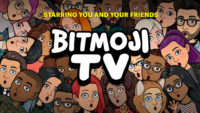Snap’s Bitmoji TV Features Users’ Avatars in Short Videos
January 31, 2020
In Snapchat’s animated series Bitmoji TV, which launches February 1, the user’s avatar stars — and the last person he Snapchatted co-stars — in various TV scenarios, including sitcoms, soap operas and reality competitions. This first season will debut 10 three-to-four-minute episodes, unveiled on Saturday mornings. As Bitmoji founder/chief executive Ba Blackstock puts it, “we’re bringing back Saturday morning cartoons.” The series takes off from Bitmoji Stories, which stars the user’s avatar in funny situations.
Engadget reports that Blackstock dubbed Bitmoji TV as “avatar-powered entertainment,” describing it as “a new category of personalized content, where it’s a unique experience for every individual viewer.” The first episode “felt like a very family-friendly ‘Futurama’ tailored to Snap’s largely Gen Z user base” and featuring some “laugh out loud” moments.

Blackstone stated that future episodes will include “really great comedians.” “So many of my friends already use their Bitmoji stickers in our chats, and I could see us getting tickled over our avatars’ latest shenanigans,” says the Engadget reporter. “I could also see Snap’s rivals trying to copy this as a way to keep younger audiences engaged, though none of them have personalized avatars like Bitmoji yet.”
TechCrunch reports that Bitmoji TV is “a massive evolution for Bitmoji beyond the chat stickers and comic strip-style Stories … [that] could help Snapchat differentiate from the plethora of short-form video platforms out there, ranging from YouTube to Facebook Watch to TikTok.”
It describes the evolution of Bitmoji TV from the startup Bitstrips, “an app for customizing the face, hair, clothes and more of your avatar and then creating comic strips for them to appear in.” In 2016, Snap purchased Bitstrips for “just $64.2 million,” and “the standalone Bitmoji app blew up as soon as Snapchat began offering the avatars as chat stickers.”

Sensor Tower reported that, as of April, “it had more than 330 million downloads.” In 2017, Bitmoji went 3D and users “could start overlaying them as augmented reality characters on [their] Snaps.” In 2018, Snap improved its graphics and then unveiled “the Snap Kit developer platform and Bitmoji Kit … [which] allows apps to build atop Snapchat login and use [their] Bitmoji as a profile pic.”
In the process, Bitmoji avatars appeared on Fitbit smartwatch faces and Venmo transactions, “part of a wise strategy to beat copycats by allowing allies to use the real thing rather than building their own knock-off.” It also fueled a rise in Snap’s share price, “from $5.79 at the start of 2019 to $16.09 now.”
Next, Bitmoji Stories let users “tap frame-by-frame through short comic strip-style interactions starring [their] avatar.” By 2019, Bitmoji had “become nearly ubiquitous amongst teens and Snapchat’s 210 million daily users.” Snap’s new game platform inside its messaging feature let its users play one another with their Bitmoji avatars and then “launched custom and branded clothing for Bitmoji.”
“With Bitmoji TV, Snap may have found a way to get users to drag their friends into the app,” TechCrunch says. “Snap would be savvy to invest in great Hollywood talent to produce the episodes … [which] could rescue Snapchat Discover from its own mediocrity.”

No Comments Yet
You can be the first to comment!
Sorry, comments for this entry are closed at this time.